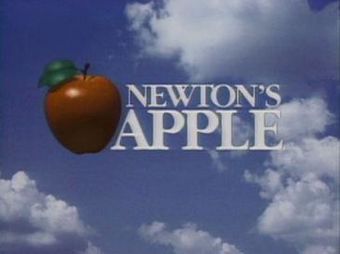Newton's Apple facts for kids
Quick facts for kids Newton's Apple |
|
|---|---|

The Newton's Apple title.
|
|
| Created by | James Steinbach |
| Starring | Ira Flatow (1983-1988) David Heil (1988-1998) Peggy Knapp (1986-1996) SuChin Pak (1995-1998) Dave Huddleston (1995-1998) Brian Hackney (1995-1998) Eileen Galindo (1996-1998) |
| Opening theme | "Ruckzuck" by Kraftwerk |
| Country of origin | United States |
| No. of episodes | 195 |
| Production | |
| Running time | 30 minutes |
| Production company(s) | KTCA |
| Release | |
| Original network | PBS |
| Audio format | Mono (1983–84) Stereo (1984–99) |
| Original release | October 15, 1983 – October 31, 1999 |
Newton's Apple was an exciting American TV show that taught viewers all about science. It was created by KTCA in Minneapolis–Saint Paul and shown on PBS stations across the United States. The show first aired on October 15, 1983, and its last new episode was on January 3, 1998. Reruns continued until October 31, 1999.
The show's name comes from a famous story about Isaac Newton. Legend says an apple fell near him (or on his head!), making him wonder why things fall. This led him to develop his important theory of gravitation. Many people say he "discovered" gravity because of this event. The main theme song for most of the show's run was "Ruckzuck" by the band Kraftwerk.
Contents
Meet the Hosts of Newton's Apple
The show had several hosts over the years who helped explain science in fun ways.
Original Hosts and Reporters
Ira Flatow was the very first host for the first five seasons. He was a familiar face who guided viewers through many scientific topics. In the sixth season, David Heil took over as the main host. He was the assistant director of the Oregon Museum of Science and Industry (OMSI) before joining the show.
Peggy Knapp joined the show in the fourth season as a field reporter. She would go to different places to report on science in action. Later, she became a co-host in the 13th season.
Later Hosts and Team Members
For the last three seasons, a team of hosts led the show. This team included Peggy Knapp, Dave Huddleston, Brian Hackney, David Heil, and SuChin Pak. In the 14th season, Eileen Galindo, an actress and voiceover artist, replaced Peggy Knapp.
Science of the Rich and Famous
A fun part of the show was a short segment called "Science of the Rich and Famous." In these clips, famous people would explain a science idea or a natural event. For example:
- Rock star Ted Nugent showed how guitar feedback works.
- Olympic gold medalist skater Scott Hamilton demonstrated how skaters spin faster by pulling their arms in, explaining angular momentum.
- Game show host Monty Hall explained ideas about probability, which is the chance of something happening.
- Actress Betty White even showed how cats purr!
Awards and Recognition
Newton's Apple was a very successful show and won many important awards. It received the Science Journalism Award from the American Association for the Advancement of Science. It also won the Parent's Choice Award, which recognizes great children's media. In 1989, the show won a Daytime Emmy Award for Outstanding Children's Series. This shows how much people appreciated its efforts to make science fun and understandable for kids.
Fun Segments and Quick Bites
In its early years, the show had a segment called "Newton's Lemons." This part of the show looked at old newsreels from the 1950s. It featured devices that were once thought to be "futuristic" but had since been forgotten. It was a cool way to see how ideas about the future change over time.
Many PBS stations also aired short clips from the series called "A Bite from 'Newton's Apple'." These were quick science facts or demonstrations shown between other TV programs.
Exploring Episodes and Topics
Newton's Apple produced a total of 195 episodes over its 15 seasons. Each episode covered a variety of science topics, from how our bodies work to amazing things in space.
Examples of Topics Covered
The show explored many different areas of science. Here are just a few examples of the kinds of topics you might have seen:
- Human Body: How our bodies work, like why our ears pop, how a hand falls asleep, or why we get goosebumps.
- Animals: Learning about different animals, such as dolphins, wolves, camels, penguins, and even tarantulas.
- Physics and Chemistry: Exploring concepts like gravity, electricity, light, sound, and how things fall or move.
- Technology: Looking at new inventions and how they work, like robots, holograms, or computer graphics.
- Nature and Environment: Understanding weather, natural disasters like earthquakes and tornadoes, and how plants grow.
The show made science exciting by showing real-world examples and doing fun experiments. It encouraged kids to ask questions and explore the world around them.

